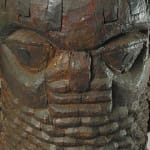Benin Wooden Head of an Oba, 1750 CE - 1897 CE
Wood
9 x 21
PF.5846
Further images
This king continues to survey his territory. His bulging eyes peer out from below his arching brow. The power and wealth of this Oba is signified by his elaborate jewelry...
This king continues to survey his territory. His bulging eyes peer out from below his arching brow. The power and wealth of this Oba is signified by his elaborate jewelry and ornamentation. In characteristic Benin style, coral necklaces rise up to his lips, symbolizing that he is overloaded with riches. He wears a beaded crown that covers his head like a net, although only the front half has been elaborated. A large feather, elegantly carved, rises from the right side of his crown. Most likely, another feather would have originally been present on the other side. While this bust represents a deceased Oba, according to Benin belief he would be even more powerful in death than in life. This image would have been worshipped on a special altar, invoking his spirit that was believed to play an active role in the lives of his lineage and the community as a whole. Originally, an ivory tusk would have been fitted through the tubular slot in the back, framed by the feathers and adding significantly to the royal majesty of the Oba. The rite of ancestor cult was pervasive throughout Benin, as represented by this head. The dead king continues to rule, now from an altar instead of a throne. The idolization of deceased relative, in the case of royalty, also served to establish a continuity of rightful rule. The force and strength of the Oba continues to penetrate the viewer. While it is now appreciated for its beautiful craftsmanship and coveted for its rarity, this head of an Oba continues to command a royal presence of power and dominance.





